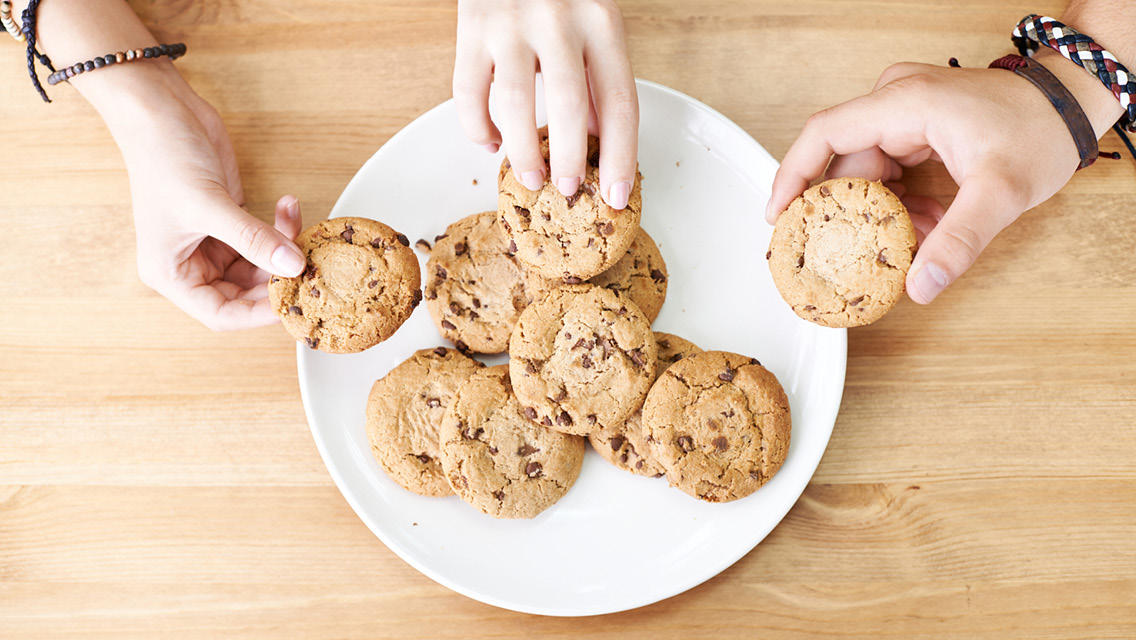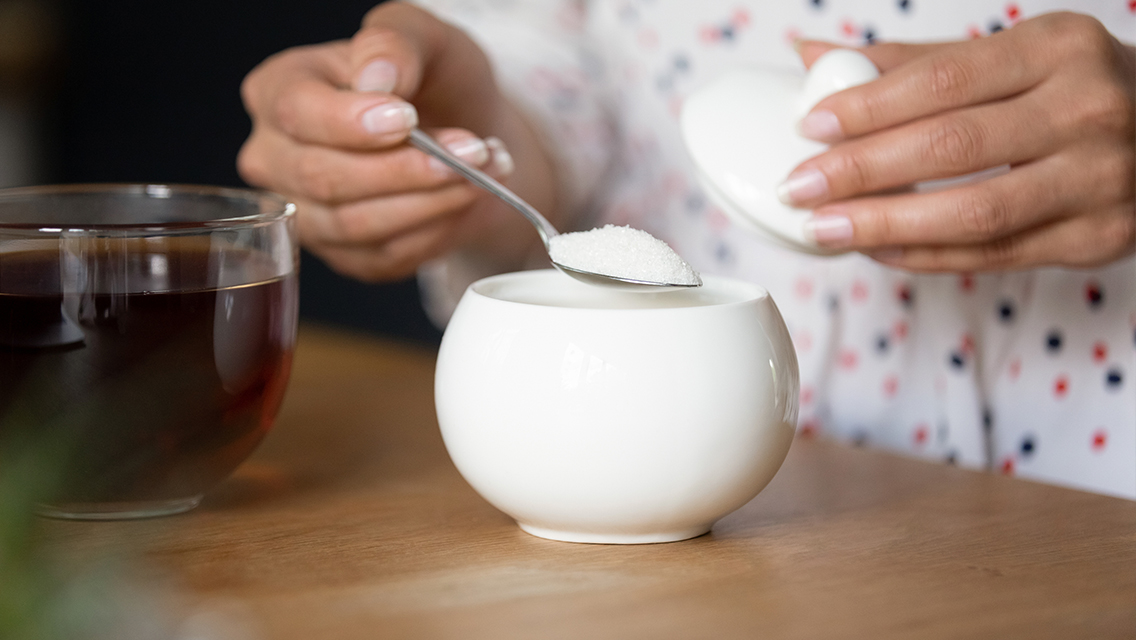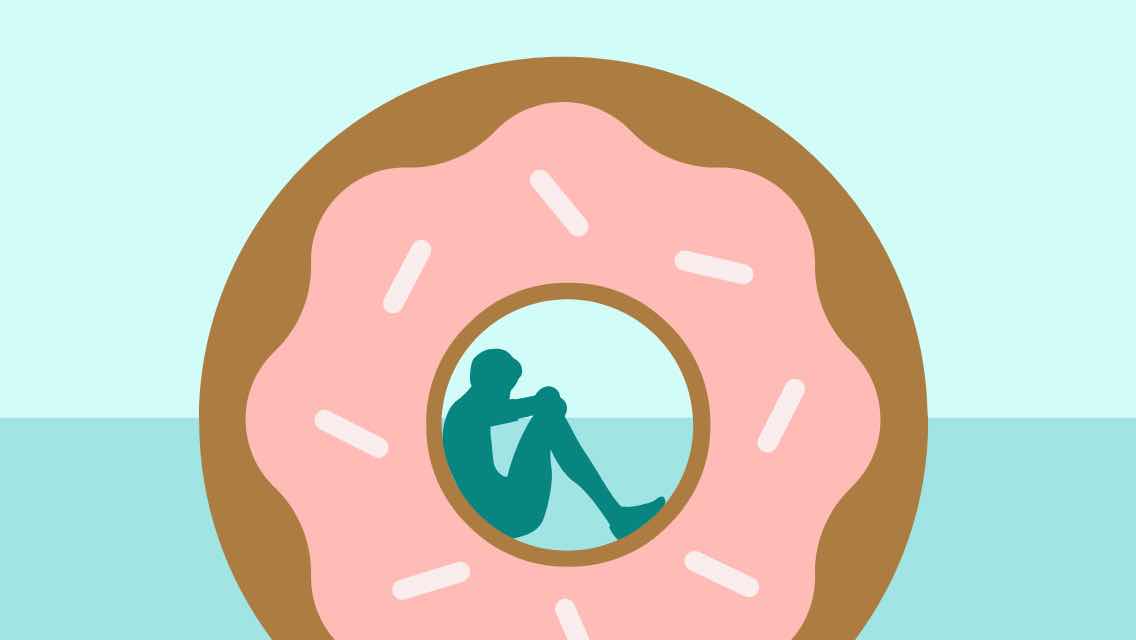Listen to the popular press and you’re left with the impression that some people really need to lighten up about sugar. It’s only sugar – the little white granules you sprinkle on cereal, the ingredient in Grandma’s cookies. Seems innocent enough.
Just the other day, I was savoring my scone at the coffee shop and reading an article that quoted William Dufty’s classic book, Sugar Blues. “Wow,” I thought, “this guy is still getting ink about a book he wrote 28 years ago!” I recalled that I started to read it myself a few years back but was put off when, on the second page, Dufty referred to sugar as a “poison.”
Poison! Webster’s defines poison as “a substance that through its chemical action kills, injures, or impairs an organism.” Sugar – a poison? Could it really be as bad as all that?
Sugar Rush
The next day, I came across a news item regarding a recently released finding by an international research group that suggested people should get no more than 10 percent of their calories from sugar. The report was commissioned by two U.N. agencies, the World Health Organization and the Food and Agriculture Organization, and was compiled by a panel of 30 international experts.
Predictably, the report was met with a storm of protest from the National Soft Drink Association, the Grocery Manufacturers of America and other interested parties who’ve maintained for years that “all foods can be part of a healthy diet when eaten in moderation and combined with the right amount of physical activity.” Clearly, they didn’t at all like the sound of this report’s version of “moderation,” which was much more specific and much more limited than previous recommendations by similar U.S. panels.
Determined to get the scoop on sugar once and for all, I hurried to my local bookstore and picked up a revised edition of Dufty’s book, along with another, more updated book: The New Sugar Busters!: Cut Sugar to Trim Fat, by H. Leighton Steward; Morrison C. Bethea, MD; Sam S. Andrews, MD; and Luis A. Balart, MD. While shopping, I perused a half dozen other sugar-related titles.
I discovered that it doesn’t really seem to matter when they were written, or by whom. You start reading these books – and there are lots of them – and you get into some serious sugar slamming. They quote innumerable studies that show how ingesting sugar instantly and significantly reduces immunity, how it impedes healing, how it stresses organs, leaches minerals and negatively impacts both mental function and mood. “Geez,” I thought, after an hour in the book aisle, “these folks make it sound like this is Drano we’re sprinkling on our corn flakes!”
Searching the Web, I found still more outspoken criticism of sugar. Several anti-sugar sites reference an annotated list compiled by Nancy Appleton, Ph.D., author of Lick the Sugar Habit. Various versions of the list, which is accompanied by a bibliography of medical, nutritional and scientific journal citations, set forth anywhere from 47 to 108 ways that “Sugar Can Ruin Your Health.” I’ll spare you the entire list, but suffice it to say it represents a very brief overview of both the best- and lesser-known criticisms of sugar – some of which seem a bit alarmist, but many of which appear to be pretty well substantiated.
I had started off thinking “These people are all hardcore hypoglycemics in need of a Krispy Kreme,” but I ended up wondering if maybe they were onto something. Even if they were totally off the mark with, say, a full hundred of the ways sugar can be ruinous to my health, that still left a good eight that could be bringing me down.
I did find several books and articles that made an argument for sugar being relatively safe – even helpful – in small quantities. Most said things like “eating a little cookie now and then won’t kill you.” Some experts even insist that natural (i.e., nonconcentrated) sugar can help create feelings of satiety and sensory satisfaction, particularly when included for flavor in small quantities as part of a larger meal.
But in my heart, I had to admit that that’s not really the way most of us eat sugar. We eat sugar day in, day out, all day long – during and between meals, as liquids and in solids, in and on everything. We eat it in quantity, and the more we eat, the more we crave.
Sugar Low
So I went home and hunkered back down with Sugar Blues. Throughout much of the book Dufty looks at history through sugar-splattered lenses. He takes us back in time to a golden era of humanity when sugar was all but absent from the diet. He explains how sugar negatively affected armies and nations as they were seduced by sweetness. He labors to link sugar to slavery; heroin, tobacco and alcohol addiction; papal oppression; the Crusades; the Plague; depression, schizophrenia; masturbation – in other words, the fellow is on a rant.
On the other hand, he makes some intriguing points, and a lot of what he says is quite convincing. Linking sugar and diabetes, Dufty asks why Hippocrates, with his keen powers of observation, did not describe diabetes. The answer? Because sugar was not in the diet and diabetes was virtually unheard of. Diabetes got on the board big time, however, once we got a taste for sweets.
In 1880, the average Danish citizen consumed 29-plus pounds of sugar a year (there’s a reason a Danish is called a Danish). At the time, the recorded death rate from diabetes was 1.8 per 100,000. By 1934, per capita sugar consumption had jumped to about 113 pounds a year, and the recorded death rate from diabetes was 18.9 per 100,000. According to the Centers for Disease Control, among U.S. adults, from 1990 to 2000 – a short 10 years – diagnosed diabetes increased 49 percent. Similar increases are expected in the next decade and beyond.
I put down Sugar Blues, feeling blue indeed, and somewhat tempted to dismiss Dufty out of hand. I mean, who was this guy? He’s not a Ph.D. or MD. For all I know he may be just another “nutrinazi” who knows his history. I checked out the dust cover on The New Sugar Busters! instead. The authors are three MDs and a CEO, and I figured they’d take a slightly more moderate stance.
To make a long book short, these guys hate sugar every bit as much as Dufty. They state that obesity, which is strongly associated with diabetes and heart disease, will soon be our No. 1 killer. Between 1958 and 1998, diabetes in America rose 600 percent and by 2015, it will increase another 150 percent worldwide. And while some continue to blame fat intake for the rise in obesity, the sugar-buster camp puts the blame squarely on sugar – and on unhealthy carbs (like crackers, chips and breads made from refined starches and flours) that convert very rapidly to sugar once ingested.
How Sugar Makes Fat
It’s possible (if you’re in denial, like me) to understand that sugar is bad for you in many ways, yet still not totally get the connection between sugar and obesity. There’s a tendency to think it’s just about “empty calories” and that as long as your caloric intake is under control, you’ll be fine. Once you understand insulin, however, your denial days are over.
Insulin, secreted by the pancreas, is the hormone required to regulate the blood sugar levels in your body. It does this by alerting your body to the presence of food energy in the system, signaling the cells to be receptive to taking in the blood sugars and fatty acids circulating in the blood.
When the breakdown and absorption of these sugars and fats happens slow-and-steady (as is the case with proteins and complex non-starchy carbs like vegetables, legumes and whole grains), your metabolism functions efficiently, turning food into a constant supply of fresh energy that your body can use at approximately the same pace it’s being produced.
Ingesting sugar and refined or starchy carbs, on the other hand, can cause a too-rapid rise in blood sugar. Unless you happen to be exercising furiously while you’re eating, your body can’t possibly use this energy all at once.
In an effort to rid the bloodstream of excess sugar, your pancreas releases a big supply of insulin, forcing the cells to accept the excess sugar, not for immediate energy, but for immediate storage as – you guessed it – fat. In some people, this insulin surge is also followed by a precipitous drop in energy and strong cravings for still more sugar.
It seems obvious that avoiding foods that trigger big releases of insulin is one of the best ways to avoid putting your body into fat-storage mode. Turn’s out it’s also one of the best ways to avoid a problem called insulin resistance, or “Syndrome X” – a pathological state in which your body ceases to “get the message” from the insulin your pancreas is pumping out.
When this happens, your pancreas churns out ever-greater quantities of insulin, but with less and less effect. Too much insulin not only promotes storage of new fat, it inhibits the breakdown of previously stored fat. It also causes cardiac enlargement, elevated cholesterol and triglyceride levels, inflammation and possibly the deposition of plaque in our coronary arteries.
A great many people – perhaps as many as 50 percent of us – are genetically predisposed to insulin resistance. Most of us aren’t actually born insulin resistant, but after years of being bombarded with a high-sugar, high-glycemic diet, the DNA in our cells freaks out. It flips a switch that causes our cells to lose their sensitivity to insulin. The results of this metabolic fiasco aren’t pretty: They include weight gain, cardiovascular disease, diabetes and a whole host of related health woes.
Sweet Sorrow
The anti-sugar experts say the solution to obesity and its sidekick diseases is to (gulp) eliminate all sugar and most high-glycemic carbohydrates that cause an “insulin intense secretion.” To do this, you not only must cease spooning sugar over your corn flakes, you have to stop eating cornflakes altogether. In fact, if you take this suggestion seriously, you must virtually eliminate most modern corn products, along with potatoes, white rice, beets and all breads, crackers, pastry and pastas made from refined flours.
Needless to say, most sweeteners are also strictly verboten. This includes all forms of sucrose (table sugar), as well as most syrup-like sweeteners (corn syrup, high-fructose corn syrup, rice syrup, molasses, even maple syrup and honey). Naturally, soft drinks are off your list, too, and so are most liquors and spirits. According to some die-hard sugar haters, beer and wine are out as well. And don’t run for the sugar substitutes and “diet” sweeteners: Most nutritional experts say these chemically derived potions are just as bad for you (or worse) for different reasons.
Whoa! Even if I wanted to swear off sugar – and after all my research, I kind of do – the task does not look like an easy one. Sugar of some sort is in nearly every bottle, bag and box of food sold at my local grocery store. It’s even in toothpaste – despite the fact that sugar is known to promote tooth decay! I can consider substitutes, but experts say the only good, natural, low-glycemic substitutes are the herb stevia or possibly agave nectar, neither of which is exactly hogging shelf space at most Piggly Wiggly stores.
Plus, some dyed-in-the-wool sugar haters insist that even these relative innocents can trigger sweet-cravings in sugar-sensitive persons. The natural fructose found in fruits is generally okay, because – assuming you don’t massively overeat – the amount is small and balanced with healthy vitamins, minerals and fiber. But if you’re watching your weight or concerned about insulin resistance, beware of overeating high-glycemic fruits like bananas, pineapple and dried fruits. Forego fruit juice for whole fruit, they say, or dilute it way down, adding just a tablespoon or so of juice to a glass of fresh water. Don’t be fooled into thinking that adding processed fructose to your food is a good idea, either! Unless fructose comes packaged in a whole fruit, you probably shouldn’t be doing business with it.
Stealth Syrup
Nutritional experts advise that we should all be particularly vigilant about one nasty ingredient called high-fructose corn syrup (HFCS). It sounds innocuous (fructose is from fruit and corn is a vegetable, after all!). It may even sound friendly and familiar (it’s one of the most common ingredients in prepared foods of all kinds). But there is perhaps no other sweetener working as hard, as fast or as effectively at making Americans fat.
According to Susan M. Kleiner, Ph.D., RD, sports nutrition expert and author of Power Eating, HFCS is “more easily turned into fat than any other carbohydrate.” High fructose corn syrup is many times sweeter than regular corn syrup. It’s also very cheap, making it an attractive ingredient for food manufacturers.
Unfortunately, it wreaks havoc on the metabolism: HFCS can’t be processed by the body like regular sugar, so a lot of it proceeds straight to the liver and fat stores. Your body doesn’t even bother giving you the chance to use it for energy! According to Kleiner, HFCS also stimulates appetite like nobody’s business.
Fructose, unlike other sugars, has less of a stimulating effect on insulin than other sugars. With less insulin stimulation, however, there is also less stimulation of the hormone leptin. Leptin, says Kleiner, helps regulate storage of body fat and helps increase metabolism as necessary to keep body weight in check. The bottom line, writes Kleiner, is that “without insulin and leptin, your appetite has no shutoff mechanism.” Her advice is to avoid buying foods and drinks with 8 or more grams of sugar on the label when HFCS is high on the list of ingredients.
Unfortunately, that’s not the sort of advice we’ve been heeding over the past few decades, and it shows on our scales. Citing the American Journal of Clinical Nutrition, Kleiner says American HFCS consumption in 1970 was about one-half pound per person per year. By 1997, that figure jumped to 62.5 pounds per person, primarily because we chugged more super-sized bottles of soda. Today HFCS consumption is on the rise, right alongside rising statistics for obesity and other sugar-related maladies.
Vow of Abstinence?
Okay, this was not what I wanted to hear, but knowing what I know now, I also know what I have to do: Cut way back. I’d be tempted to swear off sugar entirely, but cutting it out like that just seems overwhelming to me, at least cold turkey. I did it once, years ago when I was having digestion problems. After two weeks of withdrawal, I remember being amazed that I really didn’t miss sugar much at all. My mood and energy levels were more even, and I slept better. I was far less susceptible to colds and flu. I also found I was less governed by cravings of all kinds throughout the day, and as a result, my overall eating improved.
Over time, my taste for sugar changed dramatically. When something sugary did happen to pass my lips (a friend’s birthday cake, even jam on my toast), it was too much. The sweetness was cloying, and I found I didn’t want to finish the serving. I came to realize that sugar was such an overwhelming flavor force that it largely blocked the more delicate natural flavors in my food, many of which, I discovered during my sugar-free tenure, were pretty terrific in their own right.
But eventually, I had a slip. Hey, sugar is sweet, and sometimes sweet is good. Irresistibly good! Gradually, one slip led to another, and then another and another. So now I’m a sugar eater who’s longing once again for his sugar-free (or at least sugar-reduced) days. I’m determined to reform, but this time I’m taking it gradually.
One day, I find myself standing in the supermarket aisle looking at the labels of two cans of tomato soup. I love tomato soup, but I know it contains sugar. One can is Campbell’s Condensed Tomato Soup with 12 grams of sugar. The second ingredient named is the dreaded high-fructose corn syrup. The other can is Amy’s Organic Cream of Tomato with 11 grams of organic cane sugar. I choose Amy’s. A little less sugar and no high-fructose corn syrup. Plus, it’s organic.
Okay it’s only a gram difference. But it’s a start.




This Post Has 0 Comments